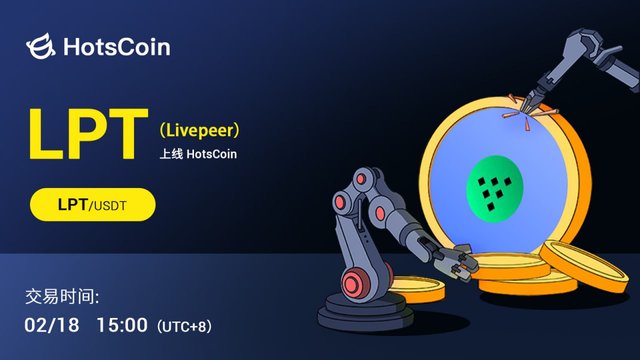Livepeer (LPT) has been launched on HotsCoin on February 18. Livepeer is a decentralized video streaming network designed to reduce the cost of real-time media transmission. This report will introduce Livepeer’s basic information, token information, key events, as well as Livepeer’s working principle, protocol, core unit, consensus mechanism, work verification, token economy and mining methods. At the same time, we have some concerns about Livepeer's security and practicality, but also recognize its potential to reduce costs in the field of video transcoding. LPT is currently open for trading on HotsCoin.

Basic information:
Founded in 2017, Livepeer is a decentralized video transcoding network built on the Ethereum blockchain. Its main goal is to provide a decentralized, highly scalable real-time streaming transport protocol to reduce the cost of video streaming applications. As of now, the number of LPT in circulation is 30,890,803.777, and the total supply is the same. The outstanding market capitalization is $386,644,973.089, which is the same as the fully diluted market capitalization.Key events:
On May 15, 2018, Livepeer was launched on the mainnet.
On February 1, 2018, Livepeer completed US$3.01 million in financing.
On June 17, 2019, Livepeer completed $8 million in Series A financing.
On July 29, 2021, Livepeer completed US$20 million in financing.
On January 5, 2022, Livepeer completed a $20 million B1 round of financing.How Livepeer works:
Livepeer is a decentralized video transcoding network. Through a proprietary "transcoder", users can contribute computing resources to the network and receive LPT token rewards. Livepeer does not provide a video platform, but provides a solution for application developers to enable them to transcode videos before playing them.Livepeer protocol:
The Livepeer protocol defines how various participants in the live broadcast ecosystem can participate in a safe and economically sound manner. The protocol allows nodes to send live video, request video, and contribute processing power and bandwidth to serve video transcoding and distribution. The protocol uses a two-layer consensus system, in which LPT ledgers and transactions are protected by the underlying blockchain, while the distribution of newly generated LPT is managed by the Livepeer smart contract.Work verification:
Livepeer uses the Truebit protocol for work verification, which allows participants to perform actual work (transcoding) and then have other participants verify the correctness of the work. The work is broken down into small steps, and the verifier examines the solver's work to find the first step that is different than expected. Economic incentives for validators ensure that checking efforts are profitable, while cheating or bug challenges are not.Token Economics and Mining:
LPT is the protocol token of the Livepeer network and can be used to delegate to transcoders, earn revenue, and perform work on the network. Mining can be done by running nodes, which mainly use GPUs to transcode videos. Staking mining is a faster way. Token holders pledge LPT to the Livepeer network and become orchestrators to obtain income.Safety and practicality concerns:
There are some doubts about the security and usefulness of Livepeer, such as whether the transcoder's verification of work is vulnerable to attacks and whether the Truebit protocol will cause an overall decrease in efficiency. However, Livepeer still has potential development prospects as an idea and option for video transcoding to reduce costs.
in conclusion:
Livepeer provides developers with solutions through a decentralized video transcoding network and reduces costs when enabling real-time media delivery. Despite some security and practical concerns, its unique protocol and token economy offer innovative possibilities for video streaming applications. As blockchain technology continues to develop, Livepeer may achieve greater success in the future.